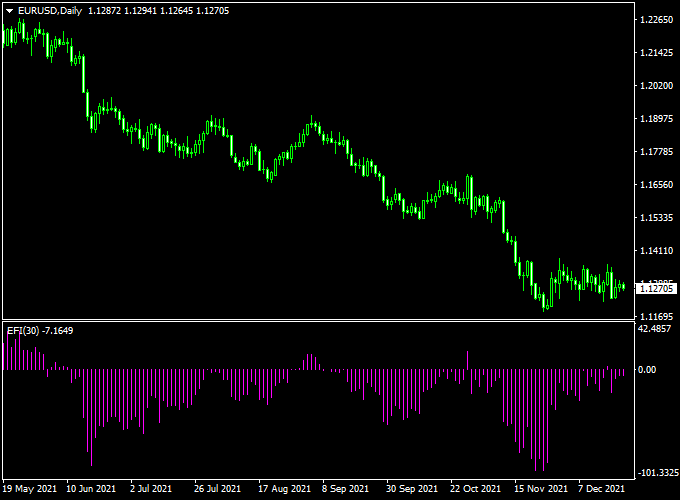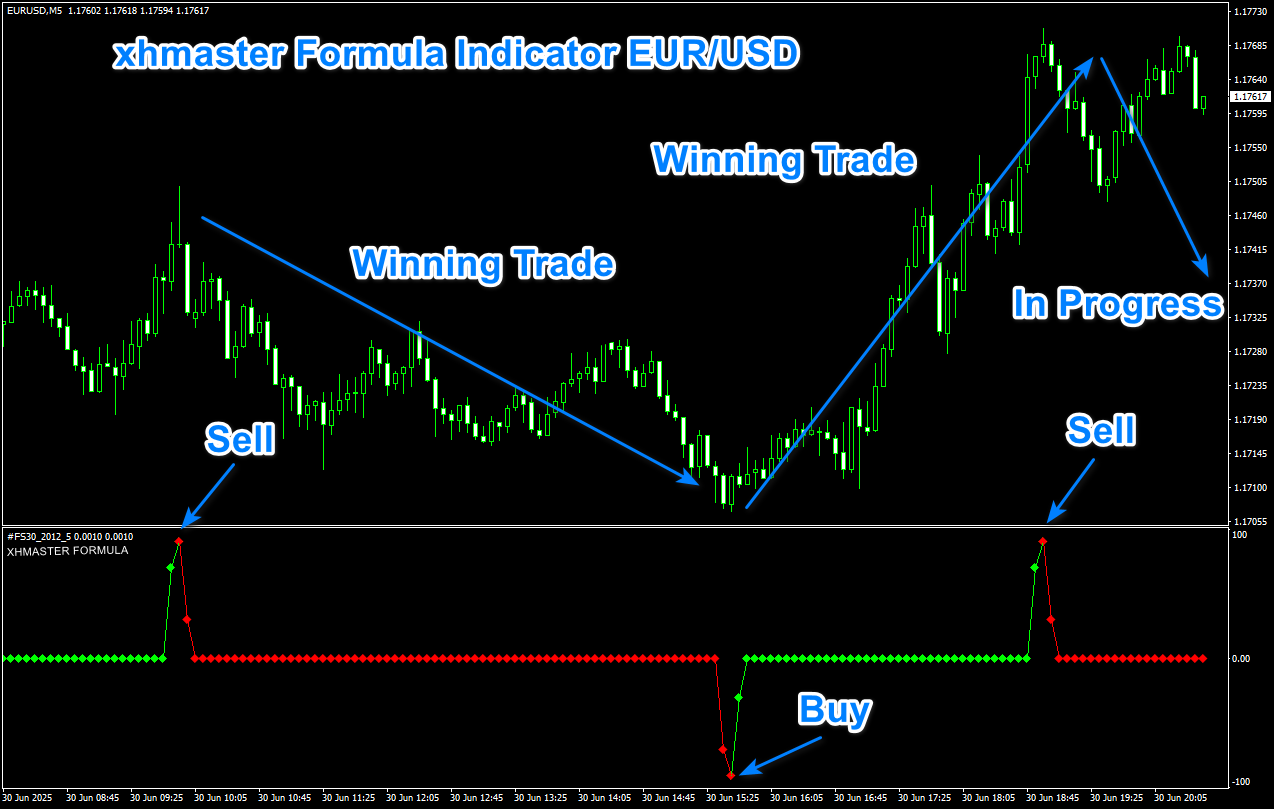The EFI Forex Signal indicator for MT4 (Metatrader 4) follows the shorter-term trend and is an excellent trade entry tool for scalpers and day traders.
The indicator appears in a separate MT4 chart window as a purple colored technical oscillator.
The EFI Forex Signal indicator can be categorized as a buy & sell oscillator that can be used in multiple ways.
Trade Idea
- Open a buy trade whenever the purple bars turn back above the 0.00 midpoint level.
- Open a sell trade whenever the purple bars turn back below the 0.00 midpoint level.
The EFI Forex Signal indicator can be used for both trade entry and exit, or as an additional confirmation filter for other strategies and systems.
The indicator works equally well on all currency pairs (majors, minors, and exotic) and shows promising results if used correctly.
Free Download
Download the “efi-indicator.mq4” indicator for MT4
Indicator Chart (EUR/USD Daily)
The example chart below displays the EFI Forex Signal MT4 indicator in action on the trading chart.
Tips:
Feel free to use your own favorite trade entry, stop loss and take profit strategy to trade with the EFI Forex Signal indicator.
As always, trade in agreement with the overall trend and practice on a demo account first until you fully understand this indicator.
Please note that even the best trading indicator cannot yield a 100% win rate over long periods.
Indicator Specifications & Inputs:
Trading Platform: Developed for Metatrader 4 (MT4)
Currency pairs: Works for any pair
Time frames: Works for any time frame
Trade Style: Works for scalping, day trading and swing trading
Input Parameters: Variable (inputs tab), color settings & style
Indicator type: Oscillator
Does the indicator repaint? No.
EFI Signal + Hourly Pivot Points MT4 Intraday Strategy
Introduction
This intraday strategy uses the EFI Forex Signal Indicator in combination with hourly pivot points indicator (support and resistance levels) to find high-probability entries within the trading day.
EFI gives a signal when momentum conditions favor a directional move.
Hourly pivots let you see key support/resistance zones where price often reacts intraday.
Together, they help you pick entries with structure, not blind signals.
The method is best on timeframes M15 and M30, although you can use M5 in very active pairs with tight spreads.
Use during active market hours (London, New York, overlap).
Pairs with liquidity and low spreads—like EURUSD, GBPUSD, USDJPY, EURJPY—work best.
Why It Works
EFI gives you a direction bias or signal when momentum supports a move.
The pivot points give context: price often stalls, reverses, or accelerates at pivot levels (R1, S1, etc.).
By combining them, you enter when momentum aligns and price is near structural zones, increasing the edge.
Buy Entry Rules
- EFI turns back above the zero level.
- Price should be above the pivot.
- Enter on the close of the confirmation candle after the EFI signal.
- Stop loss: place just under the nearest pivot support or a few pips below the recent swing low.
- Take profit: target at the next pivot resistance (e.g., R1, R2) or scale out part of the trade earlier (e.g., halfway to target). Alternatively, exit when EFI gives an opposite signal.
Sell Entry Rules
- EFI crosses back below the zero level.
- Price should be below the pivot.
- Enter on the close of the confirmation candle.
- Stop loss: place just above the nearby pivot or a few pips above the recent swing high.
- Take profit: target the next pivot support (S1, S2) or scale out. Or exit when EFI signals reverse.
Advantages
- Combines momentum (EFI) with structural zones (pivot levels) for context-sensitive entries.
- Cuts down on random signals by focusing only on pivot zones or when price tests key levels.
- Flexible exits: fixed pivot targets or dynamic exit on reverse signal.
- Works on many currency pairs with minimal adjustments.
Drawbacks
- In very range-bound sessions, the price may hover near pivots and trigger false signals.
- Spread and slippage can cut into profits, especially if entry is slightly off pivot margins.
- Pivot levels are lagging (calculated from prior periods), so they may not always align with sudden news moves.
Example Case Study 1 — EURUSD M15
Session: London morning. Price dipped close to the S1 pivot, then bounced.
EFI gave a buy signal shortly after. Price was above S1 and moving upward above the central pivot.
Trade: Entry was placed on the close of the confirmation candle.
Stop loss was just below S1. The take profit was set at the central pivot (Pivot) level.
The trade hit the target in under an hour. EFI did not reverse before the target.
Example Case Study 2 — GBPUSD M30
Session: Early US session. Price rallied to the R1 pivot and stalled.
EFI gave a sell signal while the price hovered near that pivot. Price began to reverse below the pivot.
Trade: Entry on confirmation candle close. Stop loss was placed just above R1.
Take profit set at S1 level.
Trade reached the target before midday, and volatility picked up.
Strategy Tips
- Stick to major pairs with low spreads for intraday entries.
- Trade only during active hours (London, New York, or overlap) when pivot interactions are more meaningful.
- If the price is far from any pivot (too extended), skip the signal—central pivot zones provide better context.
- Use modest position size since intraday trades accumulate many setups.







